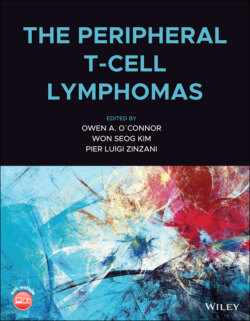Читать книгу The Peripheral T-Cell Lymphomas - Группа авторов - Страница 28
The Model of Angio‐immunoblastic T‐cell Lymphoma and T Follicular Helper‐derived Peripheral T‐cell Lymphoma
ОглавлениеAITL exemplifies a disease with a major microenvironment component. Its designation itself reflects the typically prominent vascularization of high endothelial venules and the presence of reactive immunoblasts. In fact, the neoplastic cells are often outnumbered by a polymorphous infiltrate comprising not only large B‐cell blasts, but also plasma cells, follicular dendritic cells (FDCs), reactive CD4 and CD8 T lymphocytes, eosinophils, macrophages, and mast cells. At the molecular level, up to 90% of the AITL gene expression signature can be attributed to the microenvironment, with overexpression of B‐cell (including immunoglobulins) and FDC‐related genes, chemokines and chemokine receptors (CCL19, CCL20, CCL22, CCL24, IL4) and genes related to extracellular matrix and vascular biology (such as vascular endothelial growth factor [VEGF], thrombomodulin, angiopoietin 2) [61].
A complex network of interactions between the lymphoma cells and other cell components likely takes place, and a dependency on the microenvironment is also supported by the fact that a self‐sustaining lymphoma cell line could not be established so far.
